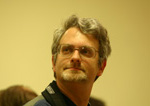





|
|
|
Large Prime Number Found by SGI/Cray Supercomputer |
||
| [chongo's home] [Astronomy] [Mathematics] [Prime Numbers] [Programming] [Technology] [contacting Landon] | ||
The largest known prime number may be found in chongo's table of
Mersenne Prime Digits and Names. <<== try me
Prime Digits Year SGI Employee
2^21701-1 6533 1978 Landon Curt Noll
(with Laura Nickel, now Ariel Glenn)
2^23209-1 6987 1979 Landon Curt Noll
2^44497-1 13395 1979 David Slowinski
(with Harry Nelson)
2^86243-1 25962 1982 David Slowinski
2^132049-1 39751 1983 David Slowinski
2^216091-1 65050 1985 David Slowinski
391581 * 65087 1989 Landon Curt Noll
2^216193-1 John Brown
Sergio Zarantonello
(with Joel & Gene Smith, Bodo Parady)
2^756839-1 227832 1992 David Slowinski
Paul Gage
2^859433-1 258716 1994 David Slowinski
Paul Gage
2^1257787-1 378632 1996 David Slowinski
Paul Gage
"Finding these special numbers is a true 'needle-in-a-haystack'
exercise, but we improve our odds by using a tremendously
fast computer and a clever program," said
David Slowinski, a
Cray Research computer scientist.
and fellow Cray
Research computer scientist
Paul Gage
developed the program that found the this large prime number.
Mathematician
Richard Crandall
independently verified that the number Slowinski and Gage found is prime.
Prime numbers have applications in cryptography and computer
systems security. Huge prime numbers like those discovered
most recently are principally mathematical curiosities, but
the process of searching for prime numbers does have several
practical benefits.
For instance, the "prime finder" program developed by
Slowinski and Gage is used by
SGI's
former Cray Research unit,
as a quality
assurance test on all new supercomputer systems. A core
element of this program is a routine that involves squaring a
number repeatedly. As this process continues, it eventually
involves multiplying immense numbers -- numbers of hundreds
of thousands of digits -- by themselves.
"This acts as a real 'torture test' for a computer," said
Slowinski. "The prime finder program rigorously tests all
elements of a system -- from the logic of the processors, to
the memory, the compiler and the operating and multitasking
systems. For high performance systems with multiple
processors, this is an excellent test of the system's ability to
keep track of where all the data is." Slowinski said the recent
CRAY T90 series supercomputer
test in which this prime number was discovered
would run for over 6 hours on one central processing unit of
the system. "If a machine can complete this exhaustive
run-through, we can be confident everything is working as it
should," said Slowinski.
In addition, Slowinski said, techniques used to speed up the
performance of the prime finder can also be used to enhance
the performance of programs customers use on real-world
problems such as forecasting the weather and searching for
oil. "Through our work on the prime finder program, we learn
new techniques for speeding up certain kinds of mathematical
operations. These operations are often key elements of the
most computation-intensive portions of software
programs our customers run on their systems," said Slowinski.
Slowinski compared running the prime finder on
supercomputers and continually "tuning" the program to
building and racing exotic cars. "There aren't many practical
uses for dragsters or Formula 1 race cars. But some things
engineers do to make those cars perform better eventually find
their way into cars you and I drive," said Slowinski.
Slowinski noted that with the discovery of this prime
number, a new
perfect number
can also be generated. A
perfect number is equal to the sum of its factors. For
example, 6 is perfect because its factors -- 1, 2 and 3 -- when
added together, equal 6. Mathematicians don't know how many
perfect numbers exist. They do know, however, that all
perfect numbers have a direct relationship to Mersenne primes.
The new perfect number generated with the new Mersenne
prime is the
34th known perfect number
and has 757,263 digits.
The 33rd known perfect number and has 517,430 digits.
Silicon Graphics is participating in the
Great Internet Mersenne Prime Search, a group of people all over
the world are using George Woltman's program in an orchestrated search for
the next Mersenne Prime.
Slowinski has verified many of the interim results
that the Internet group has sent him.
SGI's
former Cray Research unit,
creates the most
powerful, highest quality computational tools for solving the world's
most challenging scientific and industrial problems.
![[Cool Site of the Hour]](csoth.jpg) for 9 Sep 1996, 23:00 by cool central.
for 9 Sep 1996, 23:00 by cool central.
``Due to the nature of Mersenne Primes, I need an account with unlimited CPU time.''
-- Landon Curt Noll, 1977
(on a CSUH data center form justifying the need for removal of CPU
time limits on Dr. Jurca's Cyber 174 account)
|
© 1994-2013
Landon Curt Noll chongo (was here) /\oo/\ $Revision: 8.1 $ $Date: 2022/07/08 00:06:05 $ |